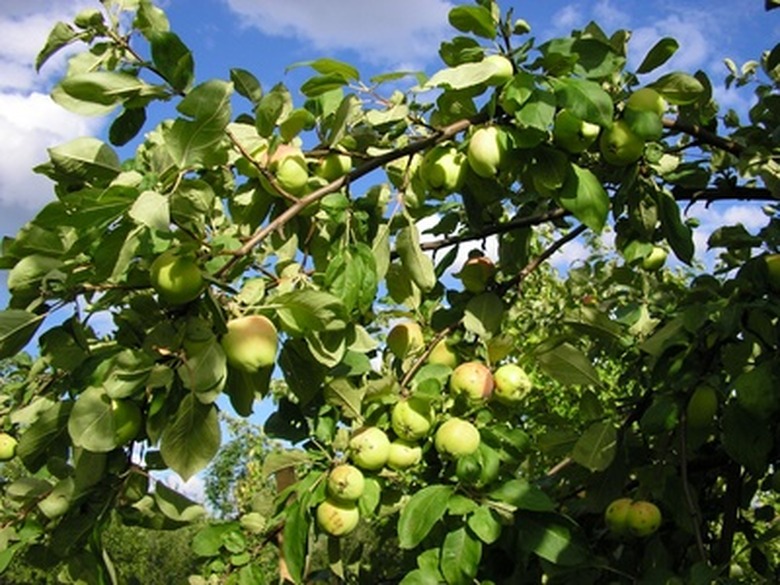How To Prune Apple Trees In The Pacific Northwest
Things Needed
- Eye protection
- Leather gloves
- Clippers or large loppers
- Pruning saw
- Chainsaw (optional)
- Ladder (optional)
Washington state apples are known as some of the best, but this popular fruit tree grows and produces well in many parts of Oregon and Northern California as well. Nine varieties of apples are grown commercially in Washington; from the red delicious to the Fuji, all trees have similar growth habits and pruning needs. Like most fruit trees, it is best to prune apple trees during their winter dormant season; follow a few guidelines to keep your apple trees healthy and productive.
Step 1
Prune young trees to encourage a central leader, which is the main vertical trunk. When your tree is a sapling, cut the main trunk to 3 feet above the level of the root crown. Use clippers or loppers and make your cut parallel to the ground. Trim off all side branches that are forming within 2 feet of the ground as well. Do not cut into the branch collar, which is a bulbous area where the branch grows from the trunk.
- Washington state apples are known as some of the best, but this popular fruit tree grows and produces well in many parts of Oregon and Northern California as well.
- Nine varieties of apples are grown commercially in Washington; from the red delicious to the Fuji, all trees have similar growth habits and pruning needs.
Step 2
Prune two-year-old trees in fall or winter. Leave only three to five scaffold branches. Leave healthy horizontal branches with an equal amount of space between them. You can also prune the central leader again at this time, or for the first time if you did not do this when the tree was a sapling. The goal is to encourage the tree to develop a pyramid shape. Use your loppers or pruning saw and be sure to cut all branches back to the collar, without cutting into the collar.
Step 3
Cut older trees in fall or winter after they have dropped their leaves. Wear sturdy gloves and goggles or other protection for your eyes. Begin by pruning all dead, broken and diseased branches back to the trunk, using a chainsaw if necessary. Be sure not to cut into the branch collar, but cut all branches as close to it as possible. Do not cut into the trunk. Cut all watersprouts, or suckers, from the tree's base, using your clippers or loppers, depending on the size of the suckers.
- Prune two-year-old trees in fall or winter.
- Use your loppers or pruning saw and be sure to cut all branches back to the collar, without cutting into the collar.
Step 4
Cut branches that are growing up or down, and those that bump into other branches. Climb a ladder to reach higher branches. If necessary, use a chainsaw, but be careful not to cut into the branch collar. You can also prune to shape your tree into a pyramid shape by leaving lower branches slightly longer than upper branches. Cut small branches with clippers or loppers and use a chainsaw for larger branches.
Step 5
Prune older, neglected trees by cutting off all dead and broken branches as well as all suckers and shoots that grow vertically from large branches. Use a ladder and chainsaw, if necessary. This practice will help to open up the tree's center and will allow more light to reach the tree. Cut all lower branches with your chainsaw back to the trunk when they occur 4 feet or less from ground level, cutting on the branch side of the collar.
- Cut branches that are growing up or down, and those that bump into other branches.
- You can also prune to shape your tree into a pyramid shape by leaving lower branches slightly longer than upper branches.
Tip
After you cut the main leader of your young apple tree, the sapling might look like nothing more than a stick, but this early pruning will help the tree to develop a strong structure. You can prune overgrown apple trees severely, but don’t expect much fruit the following season. To increase fruit production, spread severe pruning over two or three winters. Many commercial growers do not recommend using pruning tar. For very large, overgrown trees, consider hiring a professional arborist for the pruning job.
Warning
Protect your eyes and hands by wearing protective goggles and gloves. Always be careful when you use sharp tools.
